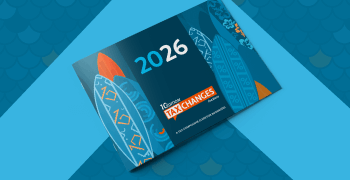
India’s new glossary on e-invoicing published by Goods and Services Tax Network
India’s Goods and Services Tax Network (GSTN), a government enterprise, has published a glossary of key terms and concepts relating to e-invoicing in India. Avalara has reproduced their definitions below for clarity and ease of reference.
By way of background, India has been rolling out e-invoicing in a phased approach since 1 January 2020. The latest wave of businesses in India to be mandated to comply with e-invoicing covers all taxpayers with annual turnover exceeding Rs 5 Crore (approximately $600,000 USD).
Phased rollout of India e-invoicing mandate
| Mandate date | Taxpayer turnover threshold |
| 1 August 2023 | Rs 5 Crore |
| 1 October 2022 | Rs 10 Crore |
| 1 April 2022 | Rs 20 Crore |
| 1 April 2021 | Rs 50 Crore |
| 1 January 2021 | Rs 100 Crore |
| 1 October 2020 | Rs 500 Crore |
| 1 February 2020 | Rs 100 Crore (voluntary period) |
| 1 January 2020 | Rs 500 Crore (voluntary period) |
Glossary on e-Invoicing
e-Invoicing
‘e-Invoicing’ means reporting details of specified GST documents to a government-notified portal i.e., Invoice Registration Portal (IRP) and obtaining an Invoice Reference Number (IRN). It doesn’t mean the generation of invoices by a government portal.
IRP (Invoice Registration Portal)
A government-approved platform where notified persons upload or report invoices. Currently, six portals are authorised to generate Invoice Reference Numbers (IRNs) on reporting of invoices as per Rule 48(4) of the CGST rules. Reporting invoices and generating IRNs on any of these portals is free of charge.
IRN (Invoice Reference Number)
The unique identifier for every invoice reported on an IRP is based on the computation of a hash of the supplier’s GSTIN, the financial year, the document type, and the document number.
AATO (Annual Aggregate Turnover)
AATO (Annual Aggregate Turnover) for e-Invoicing is calculated based on the Permanent Account Number (PAN)of a taxpayer and the information provided in their GSTR-3B returns. It represents the total turnover of the taxpayer during a financial year and is used to determine the applicability of e-Invoice reporting requirements.
Enablement
The process of registering and enabling a taxpayer for e-Invoicing on the GST portal, allowing them to report e-invoices on any of the six IRPs. Taxpayers are automatically enabled for e-Invoicing based on AATO but if not enabled they need to be self-enabled on the portal (https://einvoice.gst.gov.in).
GSTIN (Goods and Services Tax Identification Number)
A unique identification number assigned to each registered taxpayer under the GST system.
GSTR-1
A monthly or quarterly return that taxpayers need to file, which contains details of outward supplies, including e-Invoice data.
Debit Note
A document used to record a reduction in the value of a previously issued invoice, typically issued by the seller
Credit Note
A document used to record an increase in the value of a previously issued invoice, typically issued by the seller.
e-Invoice QR Code
A type of two-dimensional barcode that can be read by a digital device and provides information about the invoice. The QR code generated for e-Invoicing includes parameters such as the supplier’s GSTIN, the recipient’s GSTIN, invoice number, date of generation of the invoice, invoice value, IRN, etc.
e-Invoice QR Code Verifier App
A mobile application that allows users to scan and validate the QR codes on e-Invoices.
e-Invoice FO (Front Office) Portal
The official web portal provided by GSTN where taxpayers can access various e-Invoice-related functionalities, including enablement status, e-Invoice generation, and searching for IRNs. It also provides links to all six IRPs, e-Invoice schema, master codes, enablement status, search IRN functionality, etc. (https://einvoice.gst.gov.in)
JSON Format
JSON (JavaScript Object Notation) is a standard data interchange format. For e-Invoicing, the invoice data must be uploaded in a predefined schema INV-01 in JSON format.
API for e-Invoice Reporting
IRPs offer API-based functionality for reporting e-Invoices. API (Application Programming Interface) is a set of protocols for building and integrating software applications.
B2B Invoices
These are invoices issued in a business-to-business transaction. E-invoicing requirements in India currently apply to B2B invoices for certain taxpayers, based on their annual turnover.
ERP System
An Enterprise Resource Planning (ERP) system is a type of software used by companies to manage their day-to-day business activities. Taxpayers can continue to generate invoices from their current ERP system, but details of all such B2B invoices need to be uploaded or reported on an Invoice Registration Portal (IRP) in a notified format.
OTP
One-Time Password (OTP) is a password that is valid for only one login session or transaction. During the registration process on an IRP, an OTP is sent to the registered mobile number for verification.
Auto-population
This refers to the automatic filling in of data in a field. In the context of e-Invoicing, once an e-Invoice has been validated and has received an IRN, the data from the e-Invoice is auto-populated into the supplier’s GSTR-1 form in the GST system.
e-Invoice schema
(INV-1 - Version 1.1) The e-Invoice schema is a predefined and standardised framework that defines the structure of the e-Invoice, including mandatory and optional fields, their format and rules for the generation of an e-Invoice.
Master codes
Master codes refer to a set of pre-defined codes used in the e-Invoicing system, such as HSN codes, country codes, currency codes, state codes, and others.
Signed e-Invoice
This refers to an e-Invoice that has been digitally signed by the Invoice Registration Portal (IRP) after validation. The signed e-invoice is provided with a unique IRN and QR code.
Disclaimer: The information provided above is intended for guidance and support purposes only. Taxpayers are advised to refer to the relevant sections of the GST Act and Rules for legal definitions and interpretation. The content shared does not constitute legal advice. Users are responsible for ensuring compliance with applicable laws and regulations.
At Avalara, we make e-invoicing compliance simple. Avalara E-Invoicing and Live Reporting is a solution designed to comply with regulations in over 60 countries and we’ve got the future covered too. Our cloud-based solution is flexible, scalable, and allows you to quickly respond to new requirements. Avalara is a Certified Peppol Service Provider and is an accredited Peppol access point in Australia, New Zealand, and Japan. Contact us to discuss how Avalara can help you meet e-invoicing requirements globally.

Avalara Tax Changes 2026 is here
The 10th edition of our annual report engagingly breaks down key policies related to sales tax, tariffs, and VAT.
Stay up to date
Sign up for our free newsletter and stay up to date with the latest tax news.














